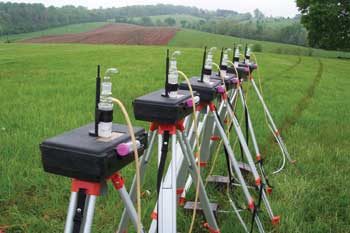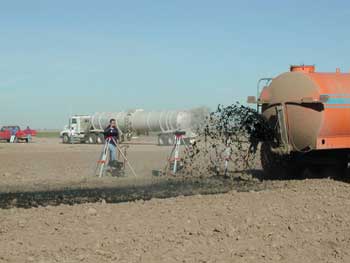Biosolids Safe for Land Application
Study shows absence of pathogens
2003
Arizona Agricultural Experiment Station Research Report
![]()
Written by
Susan McGinley
For at least two decades, wastewater treatment plants have produced Class A and B biosolids, the organic residues that result from specific treatment of sewage.
Biosolids are frequently used for land application on cropland, pastures or timberland, where they decompose while furnishing nitrogen, phosphorus and potash to growing plants. This method offers a more ecologically sound and practical alternative to domestic waste disposal than landfills or incineration, where water or air pollution may result.
Over the past two years questions have arisen over whether Staphylococcus aureus, a human disease pathogen present in raw sewage, remains in treated biosolids and potentially causes illness following its application to soil. A medically important pathogen, S. aureus causes a wide variety of human skin and wound infections, food poisoning, septicemia, toxic shock syndrome, pneumonia, meningitis, and other infections.
In a recent study, scientists at the University of Arizona have produced
evidence that S. aureus is not present in biosolids. Their report appears
in the journal Environmental Science and technology.
Chemically and biologically different from raw sewage, biosolids must meet Part 503 of the federal EPA standards regarding pathogen and heavy metal content, handling and application precautions, and other regulations.

Air samplers at work in a field near Leesburg, Virginia.
“Sixty percent of all biosolids are land-applied in the United States, but this amount covers less than 0.1 percent of agricultural land,” says Ian Pepper, a professor in the UA Department of Soil and Water Science and director of the UA National Science Foundation Water Quality Center (WQC) (see sidebar).
This center has gained national recognition, and WQC studies on land application of biosolids are being utilized by EPA as a response to a 2002 National Academy Science Report on land application.
In July 2002, after an 18-month study, the National Academy of Sciences
(NAS) issued a report stating there is “no documented, scientific
evidence that the part 503 rule has failed to protect public health regarding
land application of biosolids.” At the same time, the Academy noted
that “additional scientific work is needed to reduce persistent uncertainty
about the potential for adverse health effects from exposure to biosolids.”
Since no scientific data were available to document whether biosolids specifically contain S. aureus, Pepper and colleagues Patricia Rusin, Sheri Maxwell, John Brooks and Charles Gerba conducted biosolid and bioaerosol studies on samples from 15 different sites across the United States.
“As the saying goes, ‘Absence of evidence isn’t evidence of absence,’” Pepper says. “Our study focused on finding the scientific evidence regarding the presence or absence of S. aureus in biosolids and bioaerosols.”

An applicator called a “Slinger” catapults biosolids into the air as part of study in Mojave, Arizona.
The sampling sites ranged from the East coast to the Southwest, and all
were full-scale treatment plants; no pilot plants were included in the
study. The researchers took samples of raw sewage and untreated primary
sewage sludge in sterile bottles and transported them on ice to their
laboratory. Biosolid samples were collected in sterile containers at the
production site and likewise
transported overnight to the laboratory on ice. Each sample was assayed
for S. aureus the day it was received.
Pepper and the team collected the bioaerosol samples from four different
sites in the Southwestern United States using commercial land applicators.
“We evaluated the potential for bioaerosols from biosolids with a higher solids content using applicators called ‘slingers,’ which literally sling biosolids 80 to 100 feet through the air,” Pepper says.
“For liquid biosolids (lower solids content) the material was sprayed
from a tanker. In either case we had aerosol samplers hooked up to pumps
so that known volumes of air were sucked into a collection fluid, which
is later analyzed using cultural assays.”
The scientists analyzed all bioaerosol samples for S. aureus within 24
hours of collection.
In all, the team analyzed three raw untreated sewage samples and two undigested primary sewage sludge samples, 23 different biosolid samples, and 27 aerosols obtained during biosolid land application (biosolid aerosols).
“We detected S. aureus in samples of raw sewage and undigested primary sewage sludge,” the scientists state in their report. “However, we did not detect S. aureus in Class A or Class B biosolids after aerobic or anaerobic digestion, lime stabilization, heat-dry pelleting, and/or composting.” These are conventional methods that treatment plants use to remove disease-causing organisms from raw sewage.
“You can find S. aureus in sewage and you should be able to because one in three people have it in their systems,” Pepper says. “Yet it should be noted that none of the biosolid or biosolid aerosol samples in our study were positive for S. aureus. The most likely explanation is that wastewater treatment kills S. aureus along with other pathogenic microbes.”
Pepper notes that allegations regarding the safety of biosolids are often not based on good science.
“Overall we need more scientific studies to resolve potential issues of concern,” Pepper says. “Our study was science-based and indicates that biosolids are an unlikely source of S. aureus.”

Spray tanker spreads biosolids on farm field in Marana, Arizona.
CONTACT:
Ian Pepper
(520) 626-3328
ipepper@ag.arizona.edu
Return to the Title Page
Return to the Table of Contacts
The University of Arizona is an Equal Opportunity/Affirmative
Action Employer. Any products, services, or organizations that are mentioned,
shown, or indirectly implied in this publication do not imply endorsement
by the University of Arizona.
Published January 2004
Return to College publication list